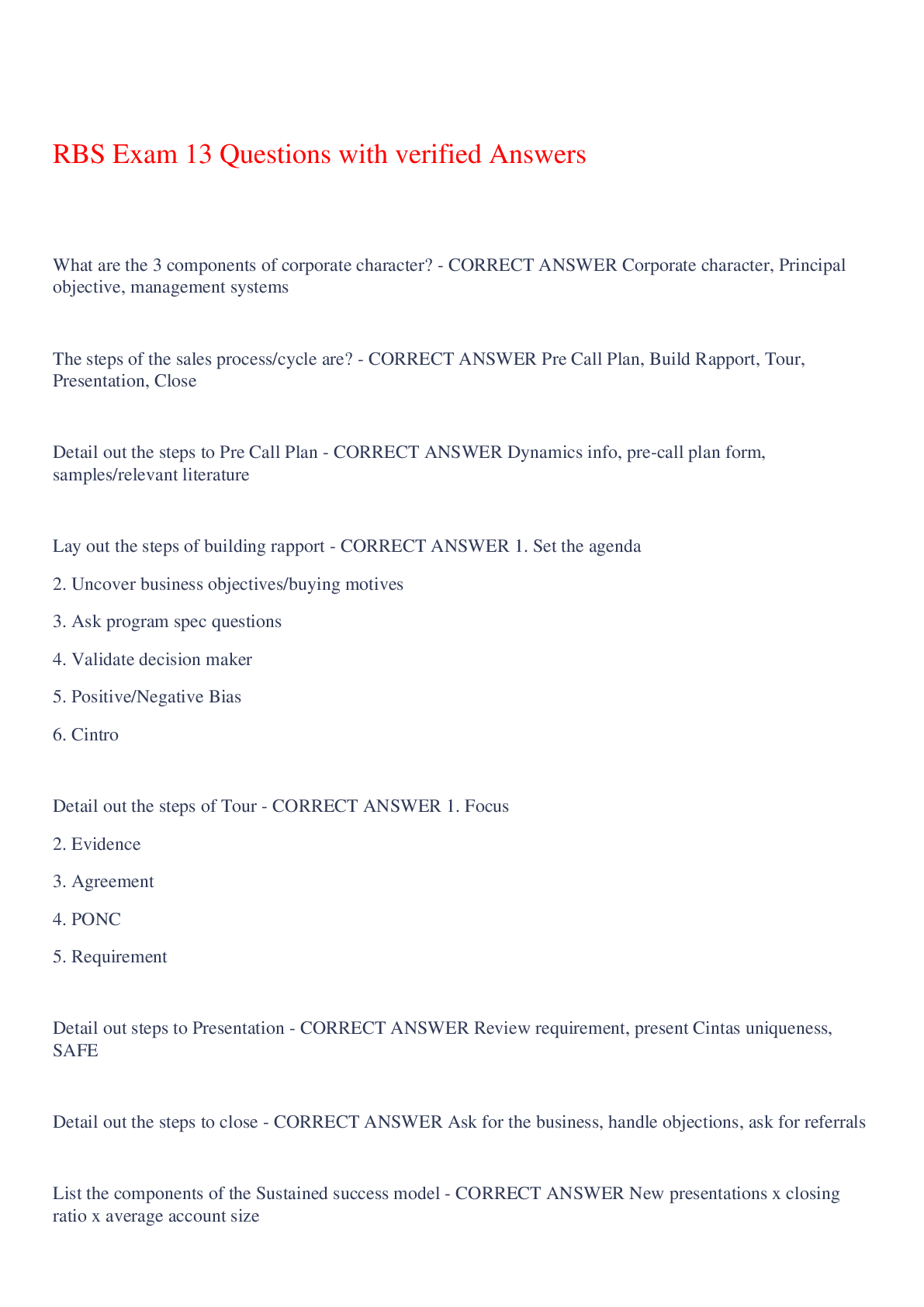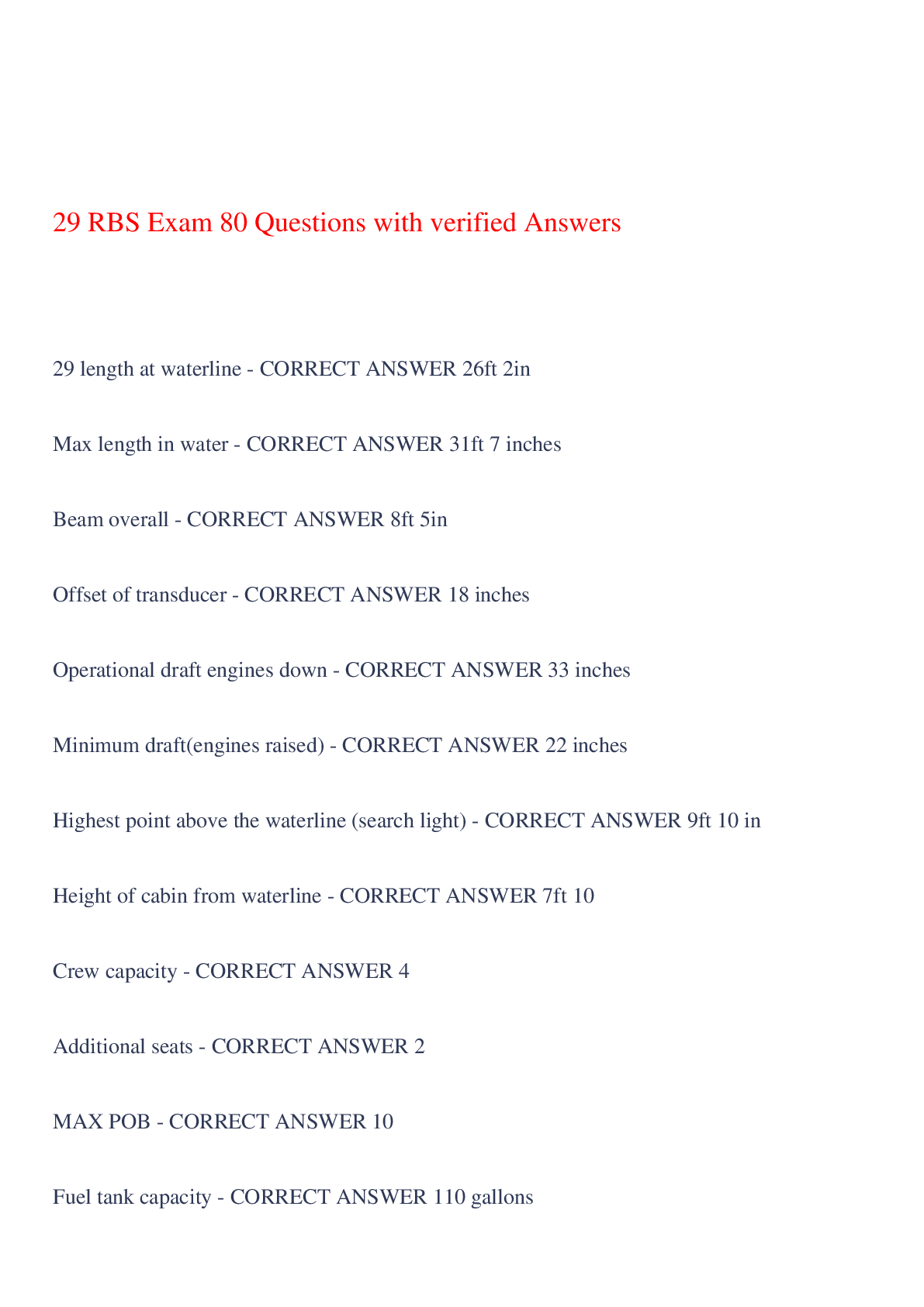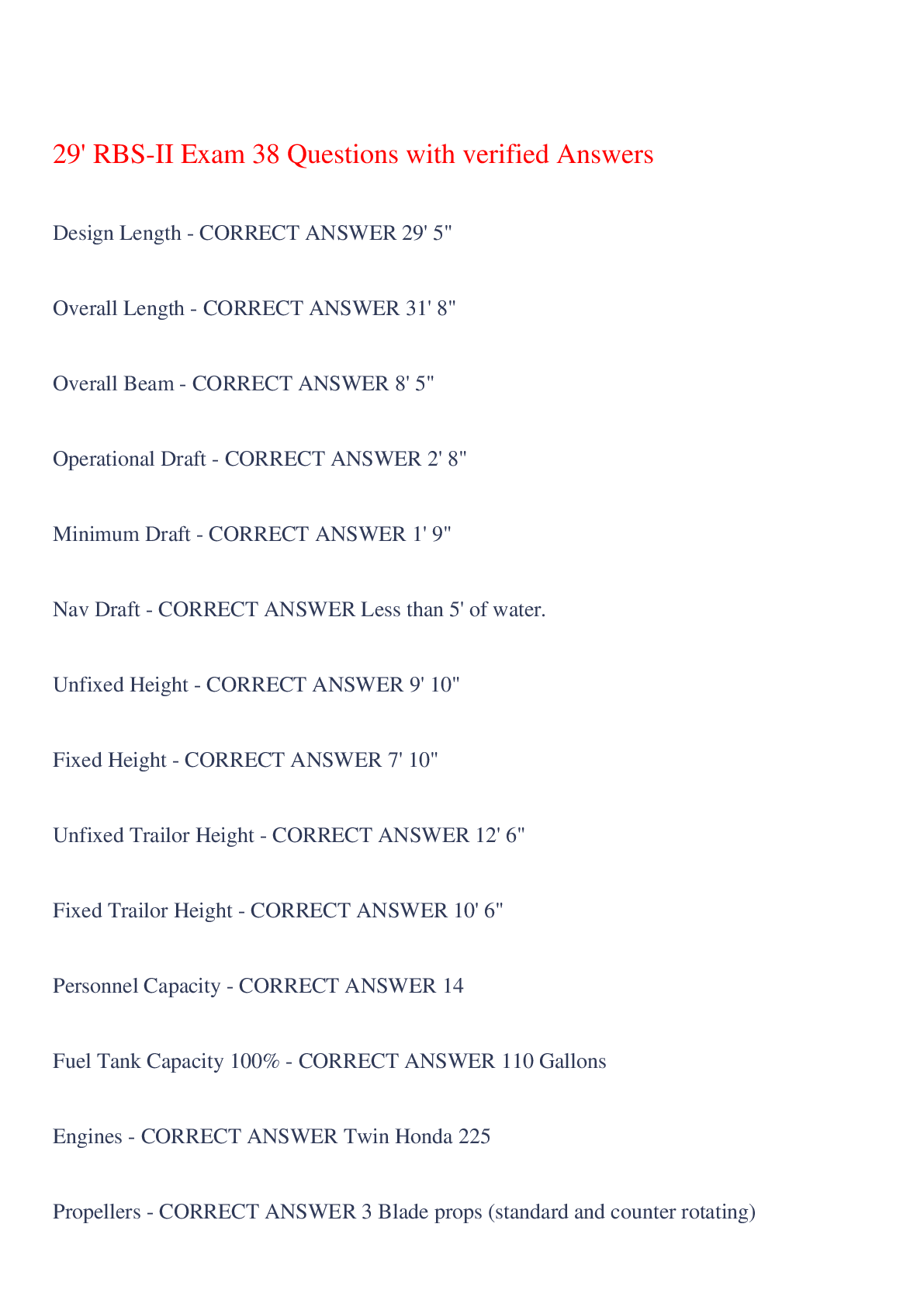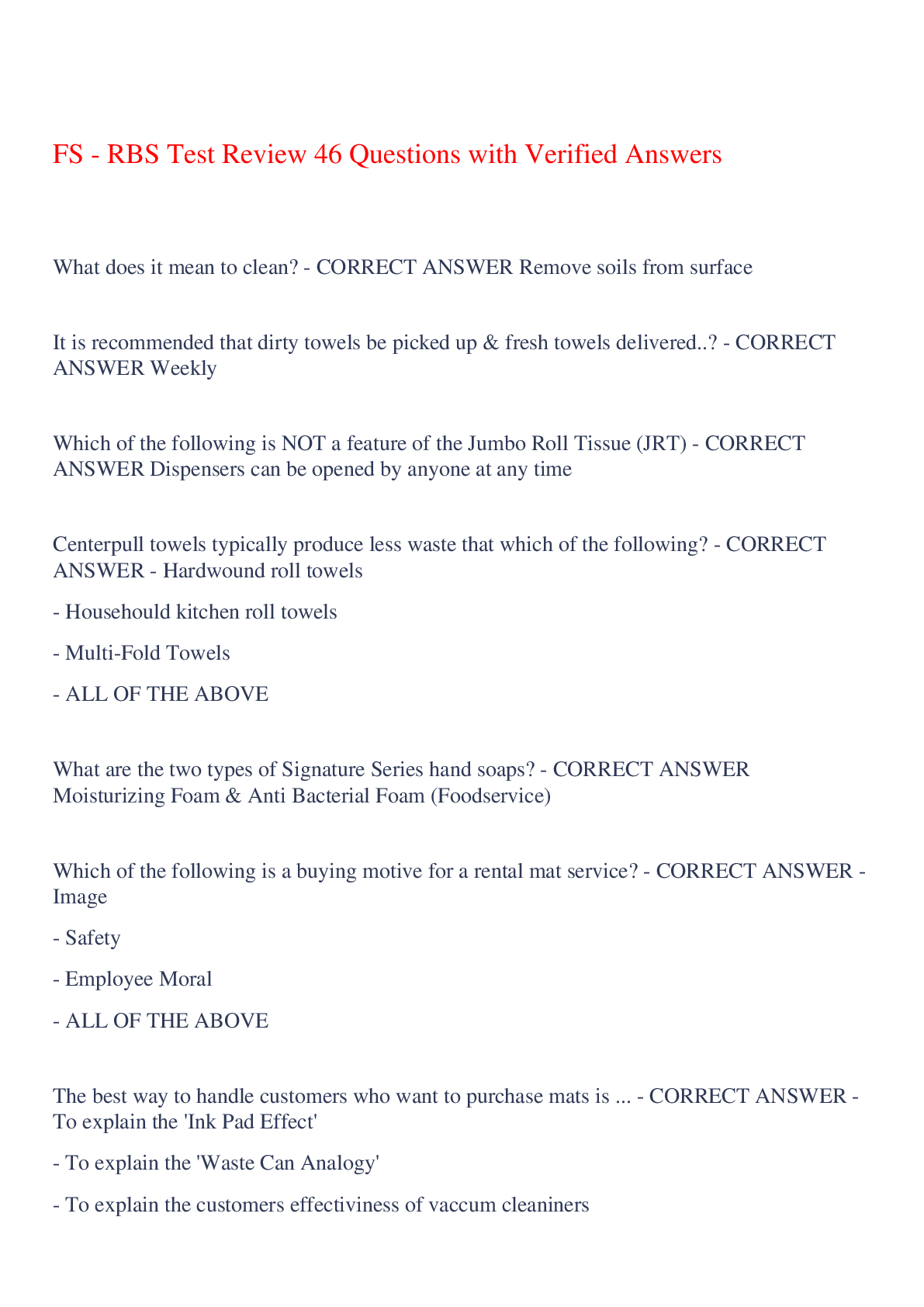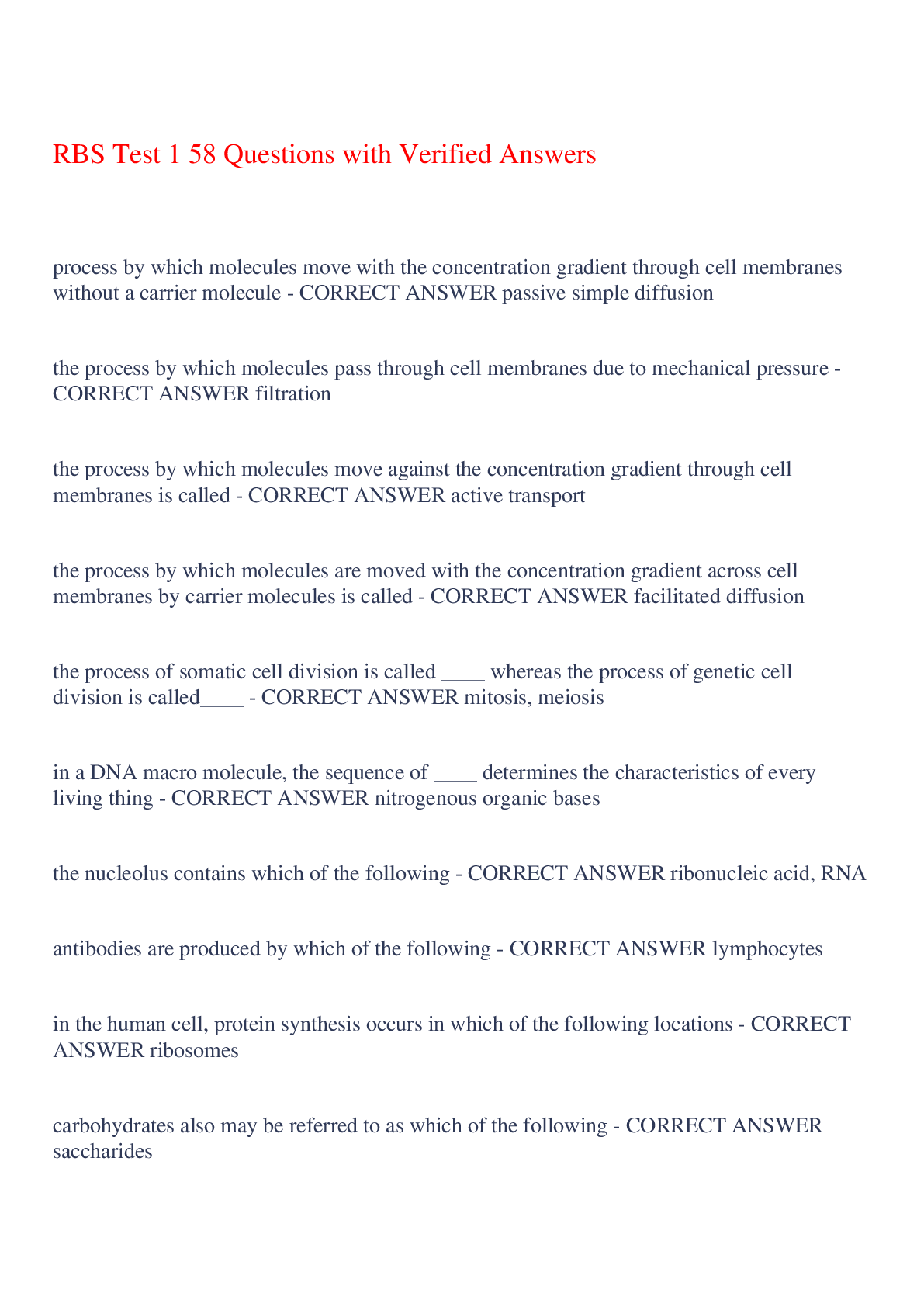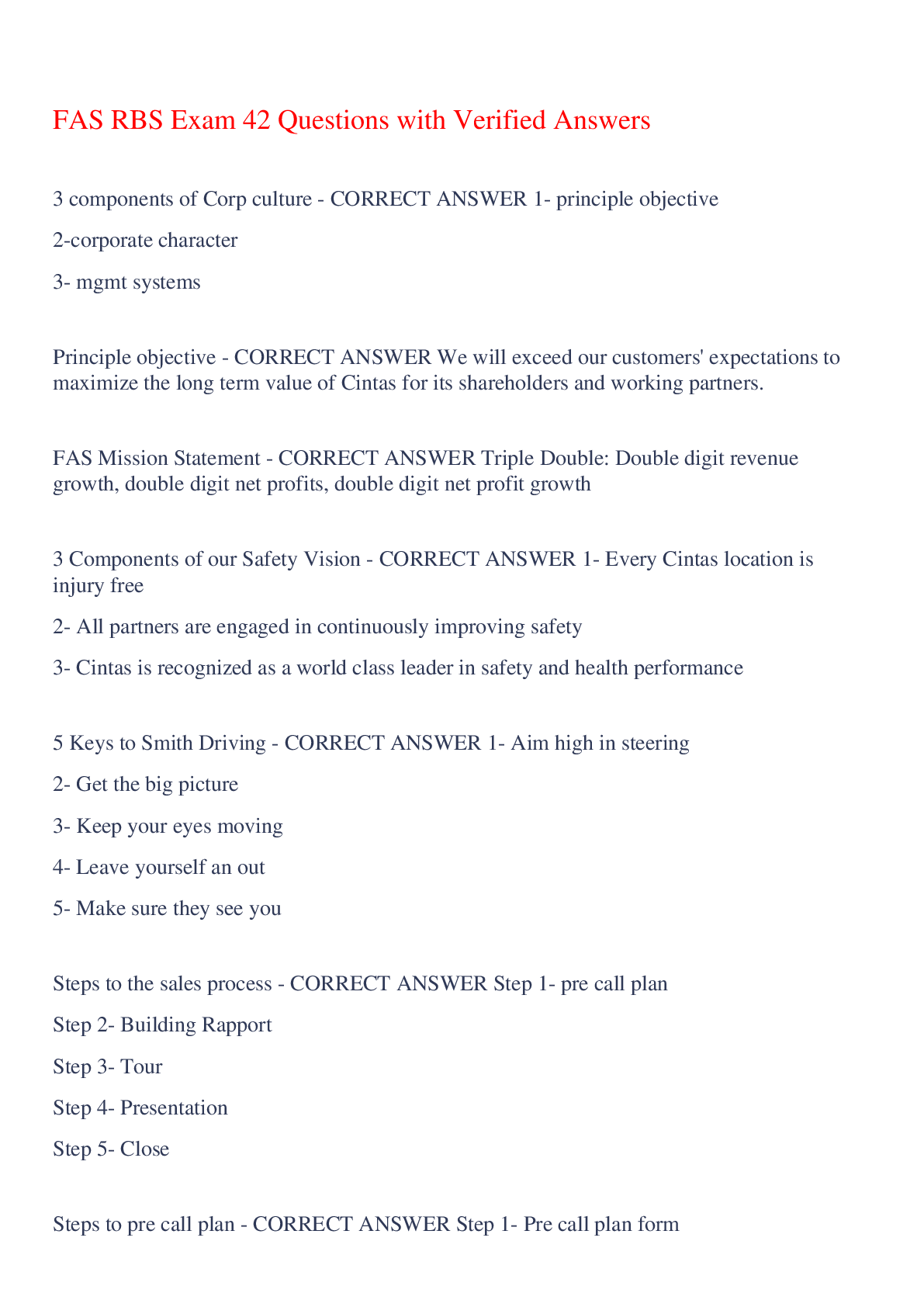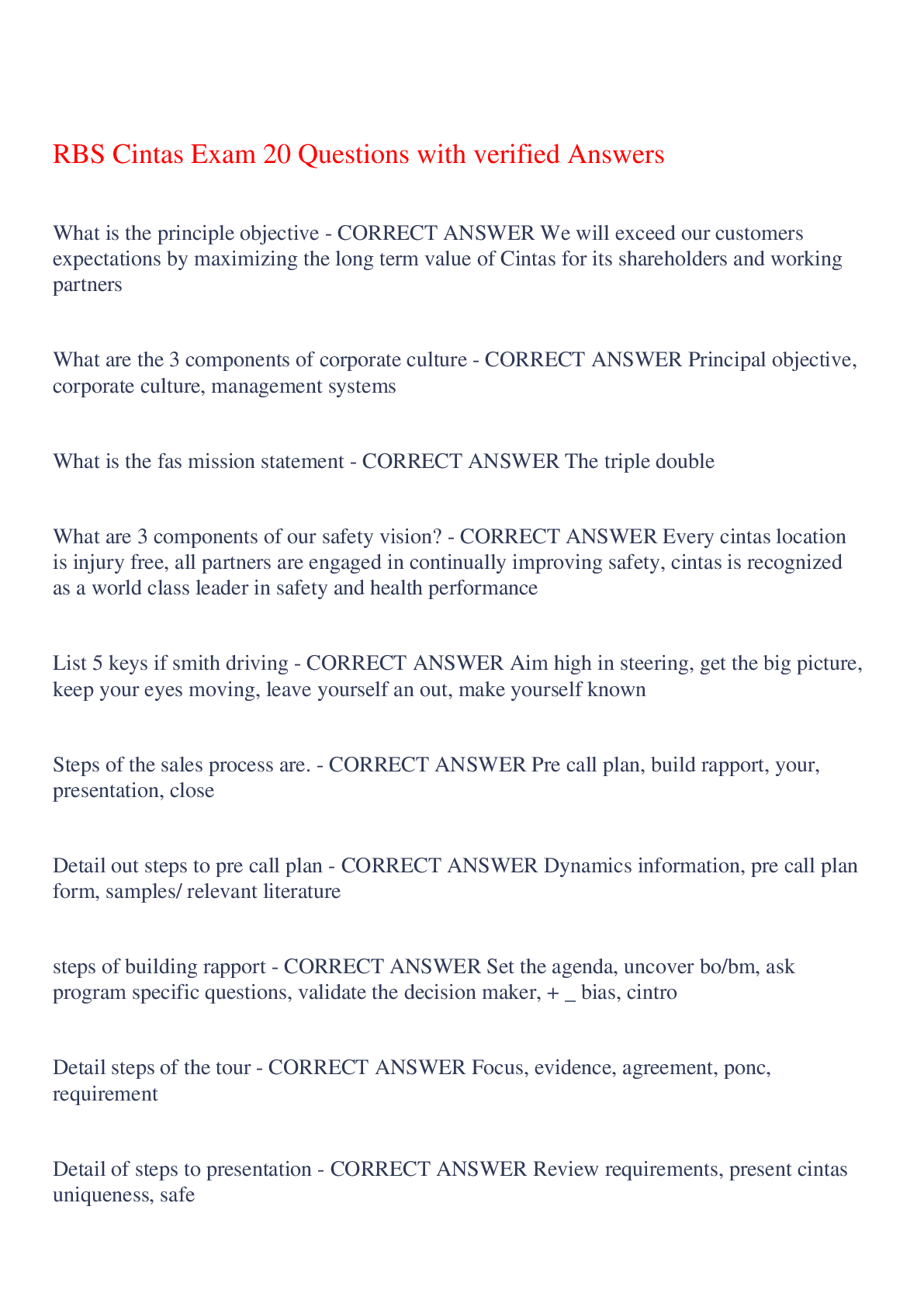Applied Science > EXAM > GED Science Exam 337 Questions with Verified Answers,100% CORRECT (All)
GED Science Exam 337 Questions with Verified Answers,100% CORRECT
Document Content and Description Below
GED Science Exam 337 Questions with Verified Answers Abiogenesis - CORRECT ANSWER Belief that livings things may develop from lifeless matter Acid - CORRECT ANSWER A compound that In water produ... ces hydrogen ions, usually tastes sour, a pH less than 7 Acid rain - CORRECT ANSWER rain containing acids that form in the atmosphere when industrial gas emissions (especially sulfur dioxide and nitrogen oxides) combine with water Alloy - CORRECT ANSWER Homogenous mixture composed of two or more metals Amoeba - CORRECT ANSWER A type of Protozoan that has no permanent shape Amorphous - CORRECT ANSWER having no definite form or distinct shape Amplitude - CORRECT ANSWER The maximum value of a wave or vibration Anaerobic respiration - CORRECT ANSWER Fermentation, or respiration in the absence of oxygen Anemia - CORRECT ANSWER lack of a normal number of red blood cells Anode - CORRECT ANSWER Positive electrode of an electrolytic cell; negative terminal of a battery; negative plate of a vacuum tube; site where oxidation occurs Antibiotic - CORRECT ANSWER compound that blocks the growth and reproduction of bacteria Antibody - CORRECT ANSWER A protein, usually in the blood of an organism, that serves to counteract the effects of disease-producing bacteriabor viruses Antidote - CORRECT ANSWER a remedy that stops or controls the effects of a poison Anticeptic - CORRECT ANSWER A substance that prevents the growth or activity of bacteria Antitoxin - CORRECT ANSWER Substance in the body neutralizes toxins Appendix - CORRECT ANSWER Wormlike, narrow part of the alimentary canal, in the lower right-hand part of the human abdomen Armature - CORRECT ANSWER A piece of metal or a coil of wire that moves back and forth, or rotates, in a magnetic field Artery - CORRECT ANSWER a blood vessel that carries blood away from the heart to the periphery of the body Arthropods - CORRECT ANSWER A group of organisms that have jointed appendages, an exoskeleton, bilateral symmetry, and reproduce sexually; insects, arachnids, millipedes and cenitpedes, and crustaceans Ascorbic acid - CORRECT ANSWER Vitamin C; found in citrus fruits, tomatoes, and green vegetables Aseptic - CORRECT ANSWER Free of living bacteria Asexual reproduction - CORRECT ANSWER Producing offspring without inion of individulaln or germ cells Assimilation - CORRECT ANSWER Process by which digested food is utilized by the body to build up or repair cells Assimilation - CORRECT ANSWER Process by which digested food is utilized by the body to build up or repair cells Asteroid - CORRECT ANSWER One of a group of "minor plants" between Mars and Jupiter, of which about 1,500 are known Atmosphere - CORRECT ANSWER The whole mass of gases surrounding a planet Atom - CORRECT ANSWER smallest particle of an element, consisting of a nucleus surrounded bynelectrons Atomic fission - CORRECT ANSWER The breaking down of an atomic nucleus, into two or more parts, with a great release of energy Atomic fusion - CORRECT ANSWER The joining of atomic nuclei to form heavier nuclei, such as deuterium (heavy hydrogen) and tritium (another isotope of hydrogen) to make helium, resulting in the release of enormous quantities of energy Auricle - CORRECT ANSWER An upper chamber of the heart thatnreceives blood from the veins-also called the atrium Autotroph - CORRECT ANSWER Organism (a green plant) that nourishes itself by making organic materials out of inorganic Auxin - CORRECT ANSWER a plant hormone that promotes root formation and bud growth Bacillus - CORRECT ANSWER aerobic rod-shaped spore-producing bacterium Bacteria - CORRECT ANSWER (microbiology) single-celled or noncellular spherical or spiral or rod-shaped organisms lacking chlorophyll that reproduce by fission Balance in Nature - CORRECT ANSWER the balence of animals and palntes in their enviroment Barometer - CORRECT ANSWER an instrument that measures atmospheric pressure Basel Metabolism - CORRECT ANSWER A term used to discribe the amount of energy the body expends when in a inactive or basic (basal) state. Base - CORRECT ANSWER any of various water-soluble compounds capable of turning litmus blue and reacting with an acid to form a salt and water Bedrock - CORRECT ANSWER solid unweathered rock lying beneath surface deposits of soil Benign Tumor - CORRECT ANSWER a tumor that is not cancerous Bile - CORRECT ANSWER a digestive juice secreted by the liver and stored in the gallbladder Binomal Nomenclature - CORRECT ANSWER the naming system for organism in wich each organsim is given a two part name-a genus name of different species in an area Biome - CORRECT ANSWER a major biotic community characterized by the dominant forms of plant life and the prevailing climate Biospy - CORRECT ANSWER taking out and examining living tissue from a living thing Brain - CORRECT ANSWER that part of the central nervous system that includes all the higher nervous centers Bronchial Tube - CORRECT ANSWER one of the pair of tubes that branch off from the trachea and go into the lungs Calorie - CORRECT ANSWER unit of heat defined as the quantity of heat required to raise the temperature of 1 gram of water by 1 degree centigrade at atmospheric pressure Cancer - CORRECT ANSWER any malignant growth or tumor caused by abnormal and uncontrolled cell division Capillary - CORRECT ANSWER long and slender with a very small internal diameter Capacitor - CORRECT ANSWER An electrical device used to store electrical charge. Carbohydrate - CORRECT ANSWER an essential structural component of living cells and source of energy for animals Carbon Dioxide - CORRECT ANSWER a heavy odorless colorless gas formed during respiration and by the decomposition of organic substances Carbon Monoxide - CORRECT ANSWER an odorless very poisonous gas that is a product of incomplete combustion of carbon Carcinoma - CORRECT ANSWER A cancerous tumor Carnivore - CORRECT ANSWER any animal that feeds on flesh Cartilage - CORRECT ANSWER strong connective tissue that supports the body and is softer and more flexible than bone Catalyst - CORRECT ANSWER (chemistry) a substance that initiates or accelerates a chemical reaction without itself being affected Cathode - CORRECT ANSWER a negatively charged electrode that is the source of electrons in an electrical device Cell - CORRECT ANSWER (biology) the basic structural and functional unit of all organisms Cell Membrane - CORRECT ANSWER thin, flexible barrier around a cell; regulates what enters and leaves the cell Cellulose - CORRECT ANSWER polysaccharide consisting of glucose monomers that reinforces plant-cell walls Cell Wall - CORRECT ANSWER strong layer around the cell membrane in plants, algae, and some bacteria Celsius - CORRECT ANSWER The metric unit of temperature measurement. Chemotherapy - CORRECT ANSWER the administration of drugs that harm the cancer cells, but that do not harm the client, or at least do not harm the client as much as the disease does Chitan - CORRECT ANSWER a carbohydrate polymer that provides structure in shells of insects and lobsters Chlorophyll - CORRECT ANSWER any of a group of green pigments found in photosynthetic organisms Chloroplast - CORRECT ANSWER organelle found in cells of plants and some other organisms that captures the energy from sunlight and converts it into chemical energy Cholesterol - CORRECT ANSWER a type of fat made by the body from saturated fat; a minor part of fat in foods Chromsome - CORRECT ANSWER structure in a cells nucleus that contains hereditary material clay - CORRECT ANSWER a very fine-grained soil that is plastic when moist but hard when fired climate - CORRECT ANSWER the weather in some location averaged over some long period of time comet - CORRECT ANSWER space object made of dust and rock particles mixed with frozen water, methane, and ammonia that forms a bright coma as it approaches the Sun compound - CORRECT ANSWER (chemistry) a substance formed by chemical union of two or more elements or ingredients in definite proportion by weight condensation - CORRECT ANSWER the process of changing from a gaseous to a liquid or solid state conductor - CORRECT ANSWER a device designed to transmit electricity, heat, etc. conglomerate - CORRECT ANSWER a composite rock made up of particles of varying size conservation - CORRECT ANSWER the preservation and careful management of the environment and of natural resources constellation - CORRECT ANSWER A group of stars that form a pattern in the sky cornea - CORRECT ANSWER transparent anterior portion of the outer covering of the eye coronary - CORRECT ANSWER the weaking of metal corpuscle - CORRECT ANSWER either of two types of cells (erythrocytes and leukocytes) and sometimes including platelets corrosion - CORRECT ANSWER the gradual wearing away of a metal element due to a chemical reaction cyclone - CORRECT ANSWER (meteorology) rapid inward circulation of air masses about a low-pressure center cyclotron - CORRECT ANSWER an accelerator that imparts energies of several million electron-volts to rapidly moving particles cytoplasm - CORRECT ANSWER a jellylike fluid inside the cell in which the organelles are suspended decibel - CORRECT ANSWER unit of measurement for the loudness of sounds deciduous - CORRECT ANSWER Trees and shrubs that shed their leaves at the end of the growing season dehyration - CORRECT ANSWER loss of water Deoxyribonuceic acid - CORRECT ANSWER A kind of nucleic acid containing the sugar, deoxyribose. Desalination - CORRECT ANSWER the removal of salt (especially from sea water) diabetes - CORRECT ANSWER any of several metabolic disorders marked by excessive urination and persistent thirst diaphragm - CORRECT ANSWER Large, flat muscle at the bottom of the chest cavity that helps with breathing diffusion - CORRECT ANSWER the act of dispersing or diffusing something digestion - CORRECT ANSWER the organic process by which food is converted into substances that can be absorbed into the body disinfectant - CORRECT ANSWER an agent (as heat or radiation or a chemical) that destroys microorganisms that might carry disease distillation - CORRECT ANSWER a process used to separate dissolved solids from a liquid, which is boiled to produce a vapor that is then condensed into a liquid ebb tide - CORRECT ANSWER outgoing or falling tide echo - CORRECT ANSWER a reflected sound wave eclipse - CORRECT ANSWER one celestial body obscures another ecology - CORRECT ANSWER the branch of biology concerned with the relations between organisms and their environment electric current - CORRECT ANSWER a flow of electricity through a conductor electrolysis - CORRECT ANSWER removing superfluous or unwanted hair by passing an electric current through the hair root element - CORRECT ANSWER an artifact that is one of the individual parts of which a composite entity is made up embryo - CORRECT ANSWER an animal organism in the early stages of growth and differentiation that in higher forms merge into fetal stages but in lower forms terminate in commencement of larval life emulsifier - CORRECT ANSWER a surface-active agent that promotes the formation of an emulsion enzyme - CORRECT ANSWER any of several complex proteins that are produced by cells and act as catalysts in specific biochemical reactions erosion - CORRECT ANSWER (geology) the mechanical process of wearing or grinding something down (as by particles washing over it) esophagus - CORRECT ANSWER the passage between the pharynx and the stomach estrogen - CORRECT ANSWER a general term for female steroid sex hormones that are secreted by the ovary and responsible for typical female sexual characteristics evaporation - CORRECT ANSWER the process by which water changes from liquid form to an atmospheric gas evolution - CORRECT ANSWER a process in which something passes by degrees to a different stage (especially a more advanced or mature stage) excretion - CORRECT ANSWER the process by which wastes are removed from the body fallout - CORRECT ANSWER radioactive particles dispersed by a nuclear explosion farsightedness - CORRECT ANSWER abnormal condition in which vision for distant objects is better than for near objects fatty acid - CORRECT ANSWER any of a class of aliphatic monocarboxylic acids that form part of a lipid molecule and can be derived from fat by hydrolysis fauna - CORRECT ANSWER all the animal life in a particular region fermentation - CORRECT ANSWER a chemical phenomenon in which an organic molecule splits into simpler substances fertilization - CORRECT ANSWER process in sexual reproduction in which male and female reproductive cells join to form a new cell filament - CORRECT ANSWER a thin wire (usually tungsten) that is heated white hot by the passage of an electric current fission - CORRECT ANSWER a nuclear reaction in which a massive nucleus splits into smaller nuclei with the simultaneous release of energy fjord - CORRECT ANSWER a long narrow inlet of the sea between steep cliffs fog - CORRECT ANSWER an atmosphere in which visibility is reduced because of a cloud of some substance food chain - CORRECT ANSWER (ecology) a community of organisms where each member is eaten in turn by another member food web - CORRECT ANSWER (ecology) a community of organisms where there are several interrelated food chains fossil - CORRECT ANSWER the remains (or an impression) of a plant or animal that existed in a past geological age and that has been excavated from the soil fossil fuel - CORRECT ANSWER fuel consisting of the remains of organisms preserved in rocks in the earth's crust with high carbon and hydrogen content fraternal twin - CORRECT ANSWER Twins who develop from two separate fertilized eggs. They are genetically no more similar than brother or sisters but they have the same fetal environment fungus - CORRECT ANSWER a parasitic plant lacking chlorophyll and leaves and true stems and roots and reproducing by spores fusion - CORRECT ANSWER the combining of images from the two eyes to form a single visual percept galaxy - CORRECT ANSWER (astronomy) a collection of star systems gallbladder - CORRECT ANSWER a muscular sac attached to the liver that secretes bile and stores it until needed for digestion gamete - CORRECT ANSWER a mature sexual reproductive cell having a single set of unpaired chromosomes gas - CORRECT ANSWER the state of matter distinguished from the solid and liquid states by: relatively low density and viscosity gasohol - CORRECT ANSWER a gasoline substitute consisting of 90% gasoline and 10% grain alcohol from corn gastric juice - CORRECT ANSWER digestive secretions of the stomach glands consisting chiefly of hydrochloric acid and mucin and the enzymes pepsin and rennin and lipase gene - CORRECT ANSWER (genetics) a segment of DNA that is involved in producing a polypeptide chain geothermal energy - CORRECT ANSWER the energy produced by heat within the earth gestation - CORRECT ANSWER the period during which an embryo develops (about 266 days in humans) glucose - CORRECT ANSWER a monosaccharide sugar that has several forms ground water - CORRECT ANSWER underground water that is held in the soil and in pervious rocks halflife - CORRECT ANSWER the time required for one half of the atoms of a radioisotope to emit radiation an decay products hard water - CORRECT ANSWER water that contains salts (as calcium and magnesium ions) that limit the formation of lather with soap hemoglobin - CORRECT ANSWER a hemoprotein composed of globin and heme that gives red blood cells their characteristic color Hemophila - CORRECT ANSWER a condition that impairs the bloods ability to clot Hereditary - CORRECT ANSWER inherited or inheritable by established rules (usually legal rules) of descent Hetrotroph - CORRECT ANSWER An organism that doesn't produce its own food Hibernation - CORRECT ANSWER the torpid or resting state in which some animals pass the winter Homeostasis - CORRECT ANSWER metabolic equilibrium actively maintained by several complex biological mechanisms that operate via the autonomic nervous system to offset disrupting changes Homogenize - CORRECT ANSWER cause to become equal or homogeneous as by mixing Homo sapiens - CORRECT ANSWER (wise humans) 1. Neaderthal- first to burry dead 2. Homo sapiens sapiens- all humans by 10k BC Hormone - CORRECT ANSWER the secretion of an endocrine gland that is transmitted by the blood to the tissue on which it has a specific effect Horsepower - CORRECT ANSWER unit for measuring the power of motors and engines Humidity - CORRECT ANSWER wetness in the atmosphere Humus - CORRECT ANSWER material formed from decaying leaves and other organic matter Hurricane - CORRECT ANSWER a severe tropical cyclone usually with heavy rains and winds moving a 73-136 knots (12 on the Beaufort scale) Hybrid - CORRECT ANSWER an organism that is the offspring of genetically dissimilar parents or stock Hydrocarbon - CORRECT ANSWER an organic compound containing only carbon and hydrogen Hydroelectric - CORRECT ANSWER of or relating to or used in the production of electricity by waterpower Hydrogen bomb - CORRECT ANSWER a nuclear weapon that releases atomic energy by union of light (hydrogen) nuclei at high temperatures to form helium Hydroponics - CORRECT ANSWER a technique of growing plants (without soil) in water containing dissolved nutrients Hypothesis - CORRECT ANSWER a tentative theory about the natural world Identical twin - CORRECT ANSWER either of two twins developed from the same fertilized ovum (having the same genetic material) Immunity - CORRECT ANSWER an act exempting someone Inertia - CORRECT ANSWER (physics) the tendency of a body to maintain is state of rest or uniform motion unless acted upon by an external force Infectious disease - CORRECT ANSWER A disease that is caused by a pathogen and that can be spread from one individual to another. Ingestion - CORRECT ANSWER the process of taking food into the body through the mouth (as by eating) Inhalation - CORRECT ANSWER the act of breathing in Instinct - CORRECT ANSWER inborn pattern of behavior often responsive to specific stimuli Insulation - CORRECT ANSWER the act of protecting something by surrounding it with material that reduces or prevents the transmission of sound or heat or electricity Insulin - CORRECT ANSWER hormone secreted by the isles of Langerhans in the pancreas Intestine - CORRECT ANSWER the part of the alimentary canal between the stomach and the anus Invertebrate - CORRECT ANSWER lacking a backbone or spinal column Ionosphere - CORRECT ANSWER the outer region of the Earth's atmosphere Iris - CORRECT ANSWER muscular diaphragm that controls the size of the pupil Jet stream - CORRECT ANSWER a high-speed high-altitude airstream blowing from west to east near the top of the troposphere Kidney - CORRECT ANSWER either of two bean-shaped excretory organs that filter wastes (especially urea) from the blood and excrete them and water in urine Kilometer - CORRECT ANSWER a metric unit of length equal to 1000 meters (or 0.621371 miles) Kinetic energy - CORRECT ANSWER the mechanical energy that a body has by virtue of its motion Lactation - CORRECT ANSWER the production and secretion of milk by the mammary glands Lagoon - CORRECT ANSWER a body of water cut off from a larger body by a reef of sand or coral Irrigation - CORRECT ANSWER (medicine) cleaning a wound or body organ by flushing or washing out with water or a medicated solution Internal combustion engine - CORRECT ANSWER an engine that burns fuel inside cylinders within the engine Larva - CORRECT ANSWER the immature free-living form of most invertebrates and amphibians and fish which at hatching from the egg is fundamentally unlike its parent and must metamorphose Larynx - CORRECT ANSWER a cartilaginous structure at the top of the trachea Latex - CORRECT ANSWER a milky exudate from certain plants that coagulates on exposure to air Latitude - CORRECT ANSWER an imaginary line around the Earth parallel to the equator Lava - CORRECT ANSWER rock that in its molten form (as magma) issues from volcanos Legume - CORRECT ANSWER an erect or climbing bean or pea plant of the family Leguminosae Leukemia - CORRECT ANSWER malignant neoplasm of blood-forming tissues Lever - CORRECT ANSWER a rigid bar pivoted about a fulcrum Lichen - CORRECT ANSWER any of several eruptive skin diseases characterized by hard thick lesions grouped together and resembling lichens growing on rocks Ligament - CORRECT ANSWER a sheet or band of tough fibrous tissue connecting bones or cartilages or supporting muscles or organs Lightyear - CORRECT ANSWER light distance travels in one year (9.5 trillion km) Limestone - CORRECT ANSWER a sedimentary rock consisting mainly of calcium that was deposited by the remains of marine animals Lipid - CORRECT ANSWER an oily organic compound insoluble in water but soluble in organic solvents Liver - CORRECT ANSWER large and complicated reddish-brown glandular organ located in the upper right portion of the abdominal cavity Loam - CORRECT ANSWER a rich soil consisting of a mixture of sand and clay and decaying organic materials Lodestone - CORRECT ANSWER a permanent magnet consisting of magnetite that possess polarity and has the power to attract as well as to be attracted magnetically Longitude - CORRECT ANSWER an imaginary great circle on the surface of the earth passing through the north and south poles at right angles to the equator Lunar eclipse - CORRECT ANSWER the blocking of sunlight to the moon that occurs when Earth is directly between the sun and the moon Lymph - CORRECT ANSWER a thin coagulable fluid (similar to plasma but) containing white blood cells (lymphocytes) and chyle Lymphocyte - CORRECT ANSWER an agranulocytic leukocyte that normally makes up a quarter of the white blood cell count but increases in the presence of infection Maggot - CORRECT ANSWER the larva of the housefly and blowfly commonly found in decaying organic matter Magma - CORRECT ANSWER molten rock in the earth's crust Malaria - CORRECT ANSWER an infective disease caused by sporozoan parasites that are transmitted through the bite of an infected Anopheles mosquito Malignant tumor - CORRECT ANSWER a tumor that is malignant and tends to spread to other parts of the body Mammel - CORRECT ANSWER an animal that has fur or hair and is fed milk from its mother's body Marine - CORRECT ANSWER native to or inhabiting the sea Marsupial - CORRECT ANSWER mammals of which the females have a pouch (the marsupium) containing the teats where the young are fed and carried Matter - CORRECT ANSWER that which has mass and occupies space Membrane - CORRECT ANSWER a thin pliable sheet of material Metabolism - CORRECT ANSWER the organic processes (in a cell or organism) that are necessary for life Metamorphosis - CORRECT ANSWER the marked and rapid transformation of a larva into an adult that occurs in some animals Meteor - CORRECT ANSWER (astronomy) any of the small solid extraterrestrial bodies that hits the earth's atmosphere Meteoroid - CORRECT ANSWER (astronomy) any of the small solid extraterrestrial bodies that hits the earth's atmosphere Meteorite - CORRECT ANSWER stony or metallic object that is the remains of a meteoroid that has reached the earth's surface Meter - CORRECT ANSWER the basic unit of length adopted under the Systeme International d'Unites (approximately 1.094 yards) Mineral - CORRECT ANSWER solid homogeneous inorganic substances occurring in nature having a definite chemical composition Mixture - CORRECT ANSWER (chemistry) a substance consisting of two or more substances mixed together (not in fixed proportions and not with chemical bonding) Mold - CORRECT ANSWER make something, usually for a specific function Molecule - CORRECT ANSWER (physics and chemistry) the simplest structural unit of an element or compound Mollusk - CORRECT ANSWER invertebrate having a soft unsegmented body usually enclosed in a shell Molting - CORRECT ANSWER process in which an arthropod sheds its exoskeleton and manufactures a larger one to take its place Natural immunity - CORRECT ANSWER immunity to disease that occurs as part of an individual's natural biologic makeup Natural selection - CORRECT ANSWER a natural process resulting in the evolution of organisms best adapted to the environment Nearsightedness - CORRECT ANSWER (ophthalmology) eyesight abnormality resulting from the eye's faulty refractive ability Nerve - CORRECT ANSWER any bundle of nerve fibers running to various organs and tissues of the body Night blindness - CORRECT ANSWER Slow recovery of vision after flashes of bright light at night; an early symptom of vitamin A deficiency Nova - CORRECT ANSWER a star that ejects some of its material in the form of a cloud and become more luminous in the process Nuclear fission - CORRECT ANSWER a nuclear reaction in which a massive nucleus splits into smaller nuclei with the simultaneous release of energy Nuclear fusion - CORRECT ANSWER a nuclear reaction in which nuclei combine to form more massive nuclei with the simultaneous release of energy Nuclear reactor - CORRECT ANSWER (physics) any of several kinds of apparatus that maintain and control a nuclear reaction for the production of energy or artificial elements Nucleus - CORRECT ANSWER the positively charged dense center of an atom Nucleus - CORRECT ANSWER a part of the cell containing DNA and RNA and responsible for growth and reproduction Nutrient - CORRECT ANSWER any substance that can be metabolized by an organism to give energy and build tissue Optic nerve - CORRECT ANSWER the cranial nerve that serves the retina Ore - CORRECT ANSWER a monetary subunit in Denmark and Norway and Sweden Organ - CORRECT ANSWER (music) an electronic simulation of a pipe organ Organic compound - CORRECT ANSWER any compound of carbon and another element or a radical Organism - CORRECT ANSWER a living thing that has (or can develop) the ability to act or function independently Oxidation - CORRECT ANSWER the process of oxidizing Oxygen - CORRECT ANSWER a nonmetallic bivalent element that is normally a colorless odorless tasteless nonflammable diatomic gas Ozone - CORRECT ANSWER a form of oxygen that has three oxygen atoms in each molecule instead of two. protects us from dangerous ultraviolet radiation from the sun Paleontology - CORRECT ANSWER the earth science that studies fossil organisms and related remains Pancreas - CORRECT ANSWER a large elongated exocrine gland located behind the stomach Parasite - CORRECT ANSWER an animal or plant that lives in or on a host (another animal or plant) Pasteurization - CORRECT ANSWER partial sterilization of foods at a temperature that destroys harmful microorganisms without major changes in the chemistry of the food Pathogen - CORRECT ANSWER any disease-producing agent (especially a virus or bacterium or other microorganism) Payload - CORRECT ANSWER the front part of a guided missile or rocket or torpedo that carries the nuclear or explosive charge or the chemical or biological agents Penicillin - CORRECT ANSWER any of various antibiotics obtained from penicillium molds (or produced synthetically) and used in the treatment of various infections and diseases Petrified - CORRECT ANSWER so frightened as to be unable to move Pharynx - CORRECT ANSWER the passage to the stomach and lungs Phosphorescence - CORRECT ANSWER a fluorescence that persists after the bombarding radiation has ceased Proton - CORRECT ANSWER a stable particle with positive charge equal to the negative charge of an electron Photosynthesis - CORRECT ANSWER synthesis of compounds with the aid of radiant energy (especially in plants) Placenta - CORRECT ANSWER the vascular structure in the uterus of most mammals providing oxygen and nutrients for and transferring wastes from the developing fetus Planet - CORRECT ANSWER any of the celestial bodies (other than comets or satellites) that revolve around the sun in the solar system Planetoid - CORRECT ANSWER any of numerous small celestial bodies composed of rock and metal that move around the sun (mainly between the orbits of Mars and Jupiter) Plankton - CORRECT ANSWER the aggregate of small plant and animal organisms that float or drift in great numbers in fresh or salt water Plasma - CORRECT ANSWER colorless watery fluid of blood and lymph containing no cells and in which erythrocytes and leukocytes and platelets are suspended plastic - CORRECT ANSWER generic name for certain synthetic or semisynthetic materials that can be molded or extruded into objects or films or filaments or used for making e.g. coatings and adhesives polio - CORRECT ANSWER an acute viral disease marked by inflammation of nerve cells of the brain stem and spinal cord pollination - CORRECT ANSWER transfer of pollen from the anther to the stigma of a plant pullutant - CORRECT ANSWER any material that harms living things that interfear with life processses pollution - CORRECT ANSWER the act of contaminating or polluting polymer - CORRECT ANSWER a naturally occurring or synthetic compound consisting of large molecules made up of a linked series of repeated simple monomers precipitation - CORRECT ANSWER the falling to earth of any form of water (rain or snow or hail or sleet or mist) prevailing wind - CORRECT ANSWER a wind that consistently blows from one direction more than from another primary light color - CORRECT ANSWER the colors red blue and green primates - CORRECT ANSWER an animal order including lemurs and tarsiers and monkeys and apes and human beings progestrone - CORRECT ANSWER Produced by the ovaries; prepares the uterus for pregnancy protein - CORRECT ANSWER any of a large group of nitrogenous organic compounds that are essential constituents of living cells proton - CORRECT ANSWER a stable particle with positive charge equal to the negative charge of an electron protoplasm - CORRECT ANSWER the living substance of a cell (including cytoplasm and nucleus) psychiatrist - CORRECT ANSWER a physician who specializes in psychiatry ptomaine - CORRECT ANSWER a term for food poisoning that is no longer in scientific use psyhology - CORRECT ANSWER Study of mental proccesses and behavior pully - CORRECT ANSWER simple machine consists of a rope that fits into the grove of a wheel pulse - CORRECT ANSWER the rhythmic contraction and expansion of the arteries with each beat of the heart pus - CORRECT ANSWER Thick yellowish-white fluid that is formed in infected wounds. It is composed of dead and dying white blood cells (principally neutrophils), tissue debris, and dead microorganisms. quarantine - CORRECT ANSWER isolation to prevent the spread of infectious disease quinine - CORRECT ANSWER a bitter alkaloid extracted from chinchona bark rabies - CORRECT ANSWER an acute viral disease of the nervous system of warm-blooded animals (usually transmitted by the bite of a rabid animal) radar - CORRECT ANSWER measuring instrument in which the echo of a pulse of microwave radiation is used to detect and locate distant objects radiant energy - CORRECT ANSWER energy that is transmitted in the form of (electromagnetic) radiation radiant heating - CORRECT ANSWER heating a building by radiation from panels containing hot water or electrical heaters radiation - CORRECT ANSWER (medicine) the treatment of disease (especially cancer) by exposure to radiation from a radioactive substance radioactivity - CORRECT ANSWER the spontaneous emission of a stream of particles or electromagnetic rays in nuclear decay recycle - CORRECT ANSWER use again after processing reflex - CORRECT ANSWER an automatic instinctive unlearned reaction to a stimulus refrigerant - CORRECT ANSWER a substance used to provide cooling (as in a refrigerator) regeneration - CORRECT ANSWER forming again (especially with improvements or removal of defects) relative humidity - CORRECT ANSWER the ratio of the amount of water in the air at a give temperature to the maximum amount it could hold at that temperature Rh factor - CORRECT ANSWER a blood group antigen possessed by Rh-positive people rotating crops - CORRECT ANSWER when crops are put through a cycle roughage - CORRECT ANSWER coarse food high in fiber but low in nutrients runoff - CORRECT ANSWER surface water that runs to the sea without entering the underground water supply rust - CORRECT ANSWER any of various fungi causing rust disease in plants Salinity - CORRECT ANSWER a measure of the amount of dissolved salts in a given amount of liquid Saliva - CORRECT ANSWER a clear liquid secreted into the mouth by the salivary glands and mucous glands of the mouth Salt - CORRECT ANSWER the taste experience when salt is taken into the mouth Satellite - CORRECT ANSWER any celestial body orbiting around a planet or star Scurvy - CORRECT ANSWER a condition caused by deficiency of ascorbic acid (vitamin C) Seed - CORRECT ANSWER A developed ovule consisting of a protective coat stored food and an embryo Short circuit - CORRECT ANSWER accidental contact between two points in an electric circuit that have a potential difference Silt - CORRECT ANSWER mud or clay or small rocks deposited by a river or lake Smog - CORRECT ANSWER air pollution by a mixture of smoke and fog Soft water - CORRECT ANSWER water that is not hard (does not contain salts that interfere with the formation of lather with soap) Solar cell - CORRECT ANSWER a cell that converts solar energy into electrical energy Solar system - CORRECT ANSWER the sun with the celestial bodies that revolve around it in its gravitational field Solid - CORRECT ANSWER of definite shape and volume Solstice - CORRECT ANSWER either of the two times of the year when the sun is at its greatest distance from the celestial equator Soluble - CORRECT ANSWER (of a substance) capable of being dissolved in some solvent (usually water) Solution - CORRECT ANSWER a method for solving a problem Solvent - CORRECT ANSWER a liquid substance capable of dissolving other substances Sound barrier - CORRECT ANSWER the increase in aerodynamic drag as an airplane approaches the speed of sound Spawning - CORRECT ANSWER method of reproduction in fishes and some other animals where a large number of eggs are fertilized outside of the body Species - CORRECT ANSWER a specific kind of something Spectrum - CORRECT ANSWER broad range of related values or qualities or ideas or activities Spontaneous combustion - CORRECT ANSWER ignition of a substance (as oily rags) resulting from an internal oxidation process Static electrcity - CORRECT ANSWER The net buildup of electric charges on an object. Sterility - CORRECT ANSWER the state of being unable to produce offspring Stimulus - CORRECT ANSWER any stimulating information or event Streptomycin - CORRECT ANSWER an antibiotic produced by the actinomycete Streptomyces griseus and used to treat tuberculosis Subatomic particle - CORRECT ANSWER a particle that is less complex than an atom Sublimation - CORRECT ANSWER (psychology) modifying the natural expression of an impulse or instinct (especially a sexual one) to one that is socially acceptable Sulfa drug - CORRECT ANSWER antibacterial consisting of any of several synthetic organic compounds capable of inhibiting the growth of bacteria that require PABA Suspension - CORRECT ANSWER a temporary debarment (from a privilege or position etc) Sweat gland - CORRECT ANSWER any of the glands in the skin that secrete perspiration Symbiosis - CORRECT ANSWER the relation between two different species of organisms that are interdependent System - CORRECT ANSWER instrumentality that combines interrelated interacting artifacts designed to work as a coherent entity Synthesis - CORRECT ANSWER reasoning from the general to the particular (or from cause to effect) Theory - CORRECT ANSWER a tentative theory about the natural world Thermodynamics - CORRECT ANSWER the branch of physics concerned with the conversion of different forms of energy Thermonuclear - CORRECT ANSWER using nuclear weapons based on fusion as distinguished from fission Thermostat - CORRECT ANSWER a regulator for automatically regulating temperature by starting or stopping the supply of heat Thunder - CORRECT ANSWER a booming or crashing noise caused by air expanding along the path of a bolt of lightning [Show More]
Last updated: 6 months ago
Preview 1 out of 28 pages
Instant download

Buy this document to get the full access instantly
Instant Download Access after purchase
Add to cartInstant download
Reviews( 0 )
Document information
Connected school, study & course
About the document
Uploaded On
Nov 20, 2023
Number of pages
28
Written in
Additional information
This document has been written for:
Uploaded
Nov 20, 2023
Downloads
0
Views
77














